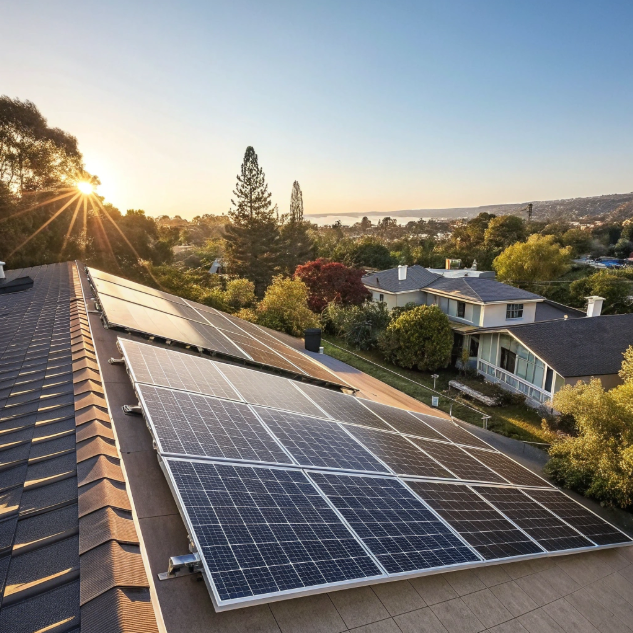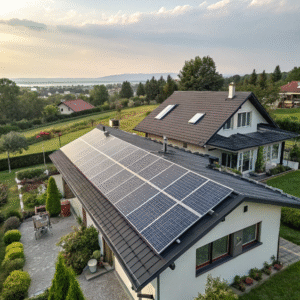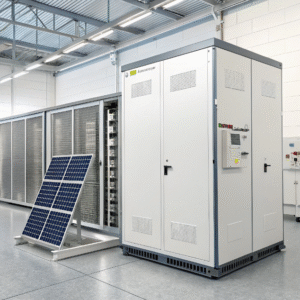PERC is Dead. TOPCon is King. A Technical Deep-Dive for Installers on Why This Shift Will Redefine Your Profit Margins in 2025.
Your customers are demanding higher efficiency, but your suppliers are pushing outdated PERC tech. The industry shift is happening now.
TOPCon technology1 offers superior efficiency, lower degradation, and better temperature coefficients than PERC, directly increasing system output and installer profits through higher energy yield per roof.

The solar landscape is transforming beneath our feet. While PERC panels dominated the last decade, a new technological king is ascending. For installers, this isn't just about specs; it's about survival and significantly fatter profit margins. Let's break down why clinging to PERC in 2025 will be a costly mistake.
The Installer's Dilemma: 'Cheap' Panels vs. 'Value' Panels. A CFO-Level Breakdown of How the Right Supplier Impacts Your Labor, Callbacks, and Bottom Line.
Tired of losing bids to competitors with rock-bottom prices? That "cheap" panel cost hides a mountain of hidden expenses.
Choosing value-driven TOPCon panels over cheap PERC reduces long-term costs by minimizing labor for callbacks, maximizing energy production revenue2, and enhancing brand reputation, leading to a higher lifetime customer value and project ROI.
The True Cost of a Callback
Let's talk dollars and cents. A single callback to troubleshoot underperforming panels can erase the entire profit margin of an installation. With PERC's higher sensitivity to shading and higher temperature-induced power loss, you're essentially building in future service visits.
- Labor Costs: Every truck roll costs $150-$300 in technician time.
- Opportunity Cost: Time spent on callbacks is time not spent on new, revenue-generating installations.
- Brand Damage: Unhappy customers leave negative reviews and don't provide referrals.
TOPCon's superior low-light performance and lower temperature coefficient mean the system performs more consistently, meeting or exceeding production estimates and keeping your phone quiet.
Analyzing the Total Cost of Ownership (TCO)
The initial price per watt is a deceptive metric. The real calculation is the Total Cost of Ownership over the system's life.
| Cost Factor | "Cheap" PERC Panel | "Value" TOPCon Panel | Impact on Installer |
|---|---|---|---|
| Initial Purchase Price | Lower | Slightly Higher | Higher upfront cost |
| Projected Annual Degradation | 0.45-0.55% | 0.30-0.40% | TOPCon produces significantly more energy over 25 years |
| Temperature Coefficient (Pmax) | -0.34%/°C to -0.40%/°C | -0.29%/°C to -0.32%/°C | TOPCon loses less power on hot days, a key installer differentiator |
| Likelihood of Shading/Low-Light Issues | Higher | Lower | Fewer customer complaints and service calls |
| System ROI for End Customer | Lower | Higher | Easier to justify price, happier customers, more referrals |
As the table shows, the "value" panel creates more value for everyone in the chain. You can command a premium price because you're delivering a premium, worry-free product.
Partnering with the Right Supplier
A value panel is only as good as the supplier behind it. The right partner provides more than just hardware; they provide peace of mind.
- Consistent Quality: Reliable suppliers have stringent quality control, reducing the risk of batch failures or early-life failures that lead to costly replacements.
- Technical Support: Access to expert technical support can help troubleshoot complex issues quickly, saving valuable time.
- Warranty Strength: A robust product and performance warranty from a bankable manufacturer is a sales tool that protects your business and your customer.
Cheaper panels always lead to higher overall profits for installers. False
Cheaper panels often result in more callbacks and lower customer satisfaction, eroding long-term profits.
TOPCon panels provide a better return on investment despite a higher initial cost. True
Superior efficiency and lower degradation3 of TOPCon lead to greater energy generation and customer savings over time.
The Invisible Profit Killer: How Potential Induced Degradation (PID) is Silently Stealing Your Project's ROI (And the Anti-PID Tech You Need).
That 5% power loss in Year 2 isn't bad luck; it's PID. And your customers will blame you for their soaring electricity bills.
Potential Induced Degradation (PID) causes significant power loss in solar panels due to voltage stress. TOPCon cells' inherent structure and advanced anti-PID technology4 dramatically reduce this risk, protecting long-term system performance and installer reputation.
What is PID and Why Should You Care?
Imagine installing a system rated for 10kW, only to find it's silently degraded to 9.5kW within a few years. This is PID. It occurs when a high voltage difference between the solar cells and the panel's grounded frame creates a leakage current, degrading the cell's ability to generate power. Hot and humid climates accelerate this process. For installers, this translates into:
- Unhappy Customers: Systems underperform promises.
- Painful Callbacks: Diagnosing PID is complex and time-consuming.
- Warranty Claims: Navigating PID-related warranty claims with manufacturers can be a nightmare.
TOPCon's Built-In Resistance
The beauty of TOPCon technology lies in its fundamental design. The tunnel oxide layer that gives TOPCon its name acts as a natural barrier against the mechanisms that cause PID. While PERC cells often require additional—and sometimes less reliable—anti-PID treatments, TOPCon's resistance is baked into the cell architecture itself. This means a more robust product from day one.
Ensuring Anti-PID Protection: What to Look For
Not all TOPCon is created equal. When evaluating suppliers, you must verify their anti-PID credentials.
| Anti-PID Feature | Why It Matters for Installers |
|---|---|
| PID-resistant Cell Technology | The inherent TOPCon structure provides a strong foundation. |
| PID-free Certified Encapsulant (EVA/POE) | The sheet that seals the cells must be high-quality to prevent current leakage. Many premium manufacturers use Polyolefin (POE) for superior moisture resistance. |
| Independent Certification (e.g., TÜV Rheinland) | Look for panels certified to withstand PID testing under stringent conditions (e.g., 85°C, 85% humidity, -1000V for 96 hours) with minimal power loss (<5%). This is your proof. |
Asking your supplier for their PID test certificates is a non-negotiable step. It separates reputable manufacturers from the rest and protects your projects from this invisible profit killer.
All solar panels are equally susceptible to Potential Induced Degradation5 (PID). False
TOPCon cell technology offers inherently better PID resistance compared to standard PERC cells.
PID can cause a system to lose more than 5% of its power output within a few years. True
Severe PID can lead to dramatic power loss, directly impacting system ROI and customer satisfaction.
"How Many Pallets Can You Ship Next Month?" - A Transparent Look at Our Supply Chain, Capacity & How We Help You Win Bigger Projects.
You've landed the big commercial job, but can your supplier deliver 500kW on time? Supply chain uncertainty is the number one cause of stalled projects and missed opportunities.
We maintain a robust, vertically integrated supply chain and strategic inventory to guarantee reliable shipping volumes, enabling installers to confidently take on larger projects and meet critical deadlines without delay.
The Vertically Integrated Advantage
Many module "manufacturers" are simply assemblers, relying on a fragile network of third-party cell and wafer suppliers. This creates bottlenecks. Our approach is different: vertical integration6. We control the production process from polysilicon to the finished panel. This means:
- Immunity to Market Shortages: When a cell supplier has an issue, it doesn't become your issue.
- Consistent Quality: Control over every manufacturing step ensures every pallet meets the same high standard.
- Cost Stability: Reduced exposure to raw material price spikes allows for more stable pricing.
Capacity That Scales With Your Ambitions
Our annual production capacity exceeds 10GW, with dedicated lines for the latest TOPCon technology. This isn't just a number; it's a commitment that we can scale with you. Whether you're a growing residential installer or a national EPC, we have the capacity to be your partner for the long haul. We provide transparent forecasts and dedicated account management to ensure your project pipeline is fully supported.
From Inquiry to Installation: Our Logistics Promise
Winning a project is one thing; completing it on time is another. Our logistics network is designed for speed and reliability.
| Logistic Stage | Our Commitment to Installers |
|---|---|
| Pre-Sales Consultation | Provide realistic lead times and volume availability before you even bid. |
| Order Confirmation | Dedicated point of contact for smooth order processing. |
| Shipping & Tracking | Consolidated shipping options; real-time container tracking. |
| On-Site Delivery | Coordinated delivery to meet your project schedule, not ours. |
This end-to-end reliability is what allows you to bid aggressively on larger projects. You're not just buying panels; you're buying certainty.
Vertically integrated manufacturers offer more reliable supply chains. True
Controlling the entire production process minimizes disruptions and ensures consistent quality.
Module supply chain issues only affect the price of panels, not project timelines. False
Supply chain delays directly cause project installation delays, leading to contractual penalties and lost revenue.
Conclusion
Adopting TOPCon technology is no longer optional; it's a strategic imperative for installers seeking higher margins, fewer callbacks, and a competitive edge in 2025 and beyond.
Explore how TOPCon technology enhances efficiency and profitability for solar installers. ↩
Explore ways to increase revenue through effective energy production strategies. ↩
Understand how lower degradation can lead to longer-lasting solar systems. ↩
Explore advanced technologies that protect solar panels from PID. ↩
Discover the impact of PID on solar panel performance and how to mitigate it. ↩
Learn how vertical integration can enhance reliability and quality in solar supply. ↩



